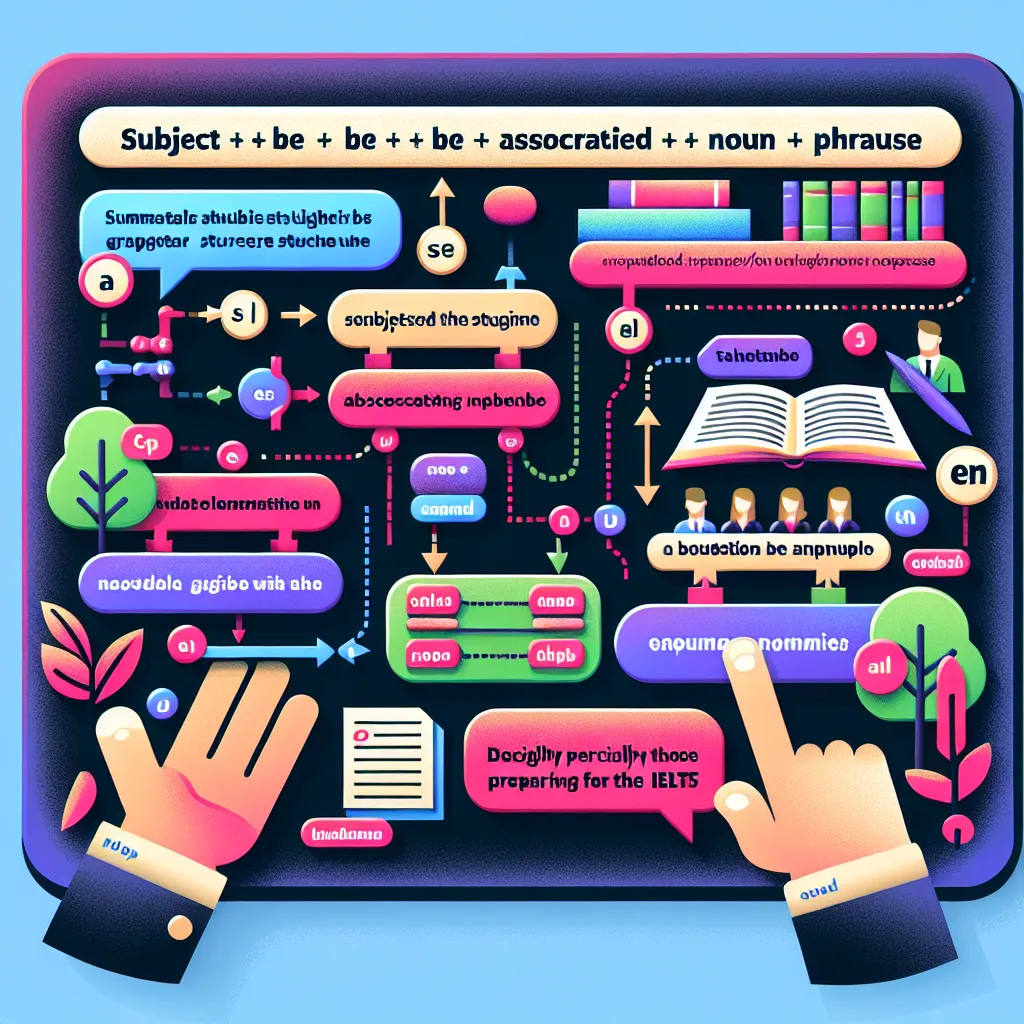The “be associated with + noun” structure is a crucial grammatical pattern that frequently appears in IELTS exams. Understanding and effectively using this structure can significantly enhance your performance across all sections of the test. Let’s delve into its meaning, usage, and application in IELTS contexts.
Understanding the “Be Associated with + Noun” Structure
The phrase “be associated with” is commonly used to express a connection or relationship between two things, ideas, or concepts. It’s a versatile structure that can be employed in various contexts, making it particularly valuable for IELTS candidates.
Formula: Subject + be + associated with + noun/noun phrase
Examples:
- Climate change is associated with rising sea levels.
- The company is associated with high-quality products.
- Her name is associated with groundbreaking research in genetics.
- This university is associated with excellence in academic research.
- The color red is often associated with danger or warning signs.
In each of these examples, the structure establishes a clear connection between the subject and the noun or noun phrase that follows “associated with.”

Frequency and Importance in IELTS
The “be associated with + noun” structure appears regularly in IELTS reading passages, listening scripts, and is highly useful in writing and speaking tasks. Its prevalence stems from its ability to express complex relationships succinctly, a skill highly valued in academic and professional contexts.
Application in IELTS Reading
In reading passages, you might encounter sentences like:
- “The decline in bee populations is associated with the widespread use of pesticides.”
- “The Renaissance period is associated with a revival of classical learning and wisdom.”
Understanding this structure helps you quickly grasp the relationships between concepts, enhancing your comprehension and speed in the reading section.
Use in IELTS Listening
During the listening test, you may hear phrases such as:
- “The company’s success is associated with its innovative marketing strategies.”
- “This particular strain of bacteria is associated with food poisoning outbreaks.”
Recognizing this structure allows you to anticipate the information that follows, improving your ability to capture key details.
Incorporating in IELTS Writing
For the writing tasks, using “be associated with + noun” can elevate your language proficiency. Consider these examples:
Task 1 (Academic):
“The graph shows that increased urbanization is associated with a rise in energy consumption.”
Task 2:
“Many argue that social media addiction is associated with decreased productivity and mental health issues among young adults.”
Enhancing IELTS Speaking Responses
In speaking tasks, this structure can help you provide more sophisticated responses:
Question: “What are some challenges facing your city?”
Response: “One of the main issues is associated with rapid population growth. This increase is associated with strain on public services and infrastructure.”
Advanced Usage and Band Score Improvement
To achieve higher band scores (7+), it’s crucial to use this structure accurately and in varied contexts. Here are some advanced applications:
-
Passive Voice:
“Certain behaviors are often associated with leadership qualities.” -
With Modifiers:
“This policy is strongly associated with improved educational outcomes.” -
In Complex Sentences:
“While economic growth is typically associated with increased job opportunities, it can also be associated with environmental degradation if not managed sustainably.” -
With Negative Forms:
“Contrary to popular belief, higher intelligence is not always associated with better academic performance.” -
In Comparisons:
“In Western cultures, the color white is associated with purity, whereas in some Eastern cultures, it is associated with mourning.”
Using these variations demonstrates a higher level of language control and can positively impact your band score.
Common Mistakes and How to Avoid Them
-
Incorrect Preposition:
Incorrect: “This brand is associated to luxury goods.”
Correct: “This brand is associated with luxury goods.” -
Confusing with Similar Phrases:
Be careful not to confuse “associated with” with phrases like “related to” or “connected to,” which may have slightly different connotations. -
Overuse:
While it’s a useful structure, overusing it can make your writing or speaking repetitive. Vary your language with synonymous expressions like “linked to,” “correlated with,” or “connected to” where appropriate. -
Incorrect Verb Form:
Incorrect: “The symptoms associate with the disease.”
Correct: “The symptoms are associated with the disease.” -
Mismatched Subject-Verb Agreement:
Incorrect: “The findings is associated with recent studies.”
Correct: “The findings are associated with recent studies.”
Conclusion
Mastering the “be associated with + noun” structure is a valuable asset for IELTS success. It allows you to express complex relationships clearly and concisely across all sections of the test. Practice incorporating this structure into your language use, paying attention to context and accuracy. Remember to vary your language and use this structure alongside other sophisticated grammatical patterns to showcase your linguistic versatility.
For further practice, look out for this structure in IELTS preparation materials and try to use it in your own writing and speaking exercises. You might also encounter similar structures like “be linked to + noun/gerund” or “be synonymous with + noun”, which can further enhance your ability to express relationships and associations in English.